Human Eye and the Colourful World Class 10 Important Questions and Answers
Important Questions for Class 10 Science Chapter 11 Human Eye and the Colourful World covers each topic of the chapter. These questions aim at providing a better understanding of the chapter to the students and can be downloaded in PDF format. These important question bank help students in clearing their doubts so that they can score well in the exam.
While preparing for exams, students should practise these important questions of Class 10 Science to understand the concepts better. Solving important questions of Class 10 Science Chapter 11 will teach students time management skills and enhance their problem-solving skills. Also, students may come across a few of these questions in the board exam.
Important Questions for Class 10 Science Chapter 11 – PDF
1. Define least distance of distinct vision.
Answer: It is the minimum distance from which our eye can see the objects clearly (or able to produce a distinct image on the retina) without any strain in our eye. It is 25 cm for a human eye means that our eye can see up to 25cm without any strain on the eye. The least distance of distinct vision is less for young people and more for old people.
2. What are bifocal lenses?
Answer: A bifocal lens consists of both convex lens as well as concave lens. It is used by the person suffering from myopia, hypermetropia, and presbyopia (not able to see very distant objects). Convex lens is used to correct hypermetropia (not able to see nearby objects clearly) and concave lens to correct myopia (not able to see far away objects clearly).
3. (i) A ray of white light breaks up into its components while passing through a glass prism. Draw a ray diagram to show the path of rays.
(ii) Mark the least deviated color in your diagram.
Answer: (i) When white light is incident on a prism, it splits into seven colors (Violet, indigo, blue, green, orange, red). And among these colors, the Red light suffers the least deviation because it has the Maximum wavelength.
(ii) The figure below shows the diagram for the same.
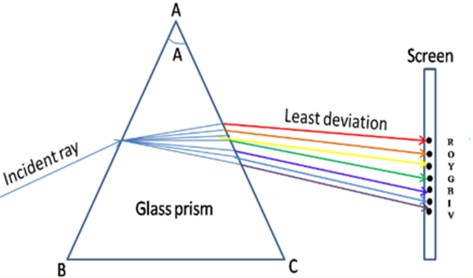
4. When a beam of white light is passed through a prism, it splits to form lights of seven colours. Is it possible to recombine the lights of seven colours to obtain the white light again? Explain your answer.
Answer: Yes, it is possible to obtain the white color from the recombination of the seven colors which are obtained by dispersion of light by prism. Figure below shows the set up for the same.

We take two glass prism and place the second one upside down w.r.t to the first one The first prism splits the white light into seven colors. When these colors fall on the inverted prism, it recombines all the colors into white light which is observed ultimately as a patch of white light on the screen.
5. A child sitting in a classroom is not able to read clearly the writing on the blackboard.
(a) Name type of defect from which his eye is suffering.
(b) With the help of a ray diagram show how this defect can be remedied.
Answer: (a) Since the student is not able to read distinctly the words written on the blackboard the student is suffering from Myopia or nearsightedness.
A myopic eye has its far point nearer than infinity. It forms the image of a distant object in front of its retina. This defect of vision occurs when the eyeball slightly elongates from front to back.
(b) This defect of vision can be remedied by using the appropriate concave lens, the concave lens is the diverging lens, therefore, it does not form the image on the retina thereby curing the defect.
Figure below shows the myopic eye without concave lens and with concave lens.

To correct this defect of vision, he must use a concave lens. The concave lens will bring the image back to the retina as shown in the given figure.

6. What do you mean by the term accommodation? Explain how the eye can see objects at far and near distances.
Answer: Accommodation is the ability or property of the eye lens to change its curvature or focal length so that images of objects at various distances can be formed on the same retina. Ciliary muscles help in changing the focal length.
Viewing of Far Off Objects: When the ciliary muscles are completely relaxed, the eye lens is thin and its focal length is maximum (equal to distance between retina and eye lens). The rays which are coming from the distant object are parallel to each other and they are focused at the retina.
Viewing nearby Objects: Ciliary muscles contract when we look at nearby objects. The eye lens bulges out and becomes thick. Focal length is reduced as a result.
7. The near point of a person suffering from hypermetropia is at 50 cm from his eye. What is the nature and power of the lens needed to correct this defect? (Assume that the near point of the normal eye is 25 cm.)

8. What is the cause for (i) Myopia and (ii) Hypermetropia? Shaw the defective eye and explain how it is corrected?
Answer: Myopia: Those who suffer from myopia can see near objects clearly, but not the far away objects. This defect of vision occurs when the eyeball slightly elongates from front to back. It is also called as Short sightedness.
Myopia is corrected with a concave lens, which curves inward like the inside of a bowl. The lens changes the focus, so images fall on the retina as they should.
Hypermetropia: Hypermetropia is also known as hyperopia or farsightedness. Those who deal with hyperopia have difficulty seeing things that are near to them but have better vision for objects that are far away.
This defect of vision arises when the lens or cornea is out of place or insufficiently curved, leading to reduced vision quality.
Depending on by how much the focal length has been altered due to the effects of hyperopia, powered convex lenses can be used for the remedy of this defect.
9. Draw a labelled diagram of human eye and explain the image formation.
Answer: The figure below shows the labeled diagram of the human eye. The main parts of eye are-
Cornea, Iris, Pupil, Ciliary muscles, Eye lens, retina and optical nerves which are labeled in the diagram below.
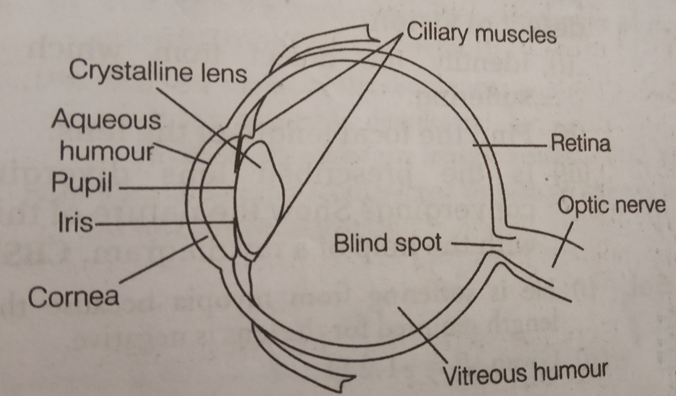
Image Formation: The light rays coming from object enter through cornea of eye, pass through the pupil of the eye and fall on the eye lens. The eye lens is a convex lens, so it produces real and inverted image of object.
The optical nerve conveys the image formed on retina to brain and we get sensation of vision.
10. Define the term power of accommodation. Write the modification in the curvature of the eye which enables us to see the nearby objects clearly. What are the limits of accommodation power of a healthy normal human eye ?
Answer: Accommodation power is the property of the eye lens to adjust its focal length so as to focus objects situated at different distances from the eye on the retina.
When the ciliary muscles are relaxed, the eye lens becomes thin and its focal length is maximum and equal to the diameter of the eye ball. In this condition, one can see distant objects clearly.
At the time of looking at nearby objects the ciliary muscles of eye contract and eye lens becomes thicker. Consequently, focal length of eye lens decreases and nearby objects are clearly focussed at the retina.
There are definite limits of accommodation power for a healthy normal eye. The farthest distance, up to which an eye can see objects clearly, is called the far point of eye and its value is infinity. The minimum distance, up to which an eye can see distinctly, is known as near point of eye and its value is 25 cm for a normal eye.
11. When do we consider a person to be myopic ? List two causes of this defect.
Explain using a ray diagram how can this defect of eye be corrected?
Answer: A person is said to have a myopic vision, if he can see objects situated near the eye clearly but cannot clearly see distant objects. If a person can see clearly upto a distance ‘x’ from the eye then it means that far point of eye has shifted from infinity to a point O situated at distance V from the eye.
Naturally light rays coming from a distant object (u = ∞) are focussed in front of retina of eye.
Two possible causes of myopia are :
(i) Either the power of the eye lens has become more than its normal value due to excessive curvature of the cornea (focal length of eye lens has decreased) or
(ii) Elongation of the eyeball due to some genetic defect.
To rectify this defect a concave lens of focal length f is used, which may form the virtual image of the distant object at the far point of defective eye (i.e., u = – ∞ and v = – x ) so that now the defective eye may form the image at the retina.
Obviously, by using lens formula, we have

The ray diagram of defective eye and its rectification are shown here.
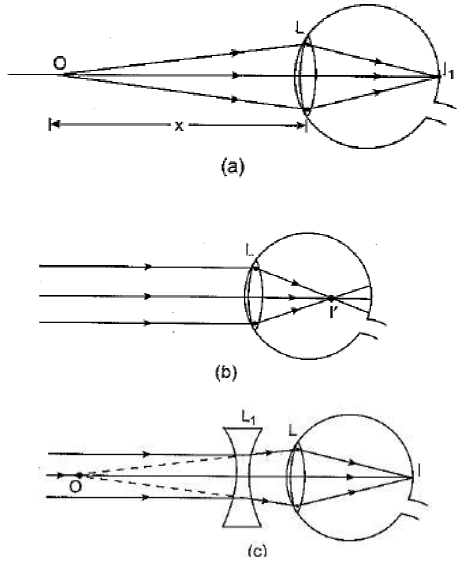
12. Name two defects of vision. Mention their cause and the type of lenses used to correct them.
Answer: Two main defects of vision, their cause and correction are as follows :
(1) Myopia – In myopia or near-sightedness (or short-sightedness), a person can see nearby objects clearly but cannot see distant objects distinctly. For a myopic eye, the far point is not at infinity but has shifted nearer to the eye.
Myopia arises due to either (i) excessive curvature of the cornea, or (ii) elongation of the eyeball.
Myopia can be corrected by using a concave lens whose focal length has same numerical value as the distance of far point of the defective eye.
(2) Hypermetropia – In hypermetropia or long-sightedness, a person can see distant objects distinctly but cannot see nearby objects so clearly. For a longsighted eye, the near point is not at 25 cm but has shifted away from the eye.
Hypermetropia arises either because
(i) the focal length of eye lens is too large, or
(ii) contraction of the eyeball.
Hypermetropia can be corrected by using suitable convex lens, which forms virtual image of the object situated at 25 cm at the near point of defective eye so that now the eye lens can focus it on the retina.
13. What is a rainbow? Draw a labelled diagram to show the formation of rainbow.
Or
Describe the formation of rainbow in the sky with the help of a diagram.
Answer: A rainbow is a natural spectrum appearing in the sky after a rain shower. Rainbow is caused by dispersion of sunlight by tiny water droplets hanging in the atmosphere after a rain shower. The water droplets act like small prisms. As shown in figure, the water droplets refract and disperse the incident sunlight. These rays are then reflected internally and finally refracted again and come out of rain drop. Due to the dispersion and internal reflection of light different colours reach the observer’s eye and rainbow is seen.
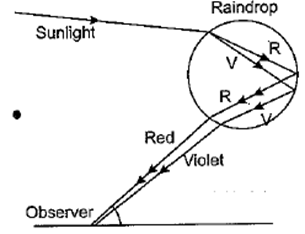
An important point to be noted here is that a rainbow is always formed in a direction opposite to that of Sun.
14. What is atmospheric refraction? Briefly explain. Why does apparent position of a star appear different from its true position?
Answer: Atmospheric air layer just near the earth surface is comparatively denser and upper layers of atmosphere are successively rarer and more rarer. Hence, a light ray passing through atmospheric air undergoes refraction. Since the physical conditions of air are not stationary, the apparent position of the distant object, as seen through the air, fluctuates. It is known as an effect of atmospheric refraction.
Light coming from a distant star on entering into the earth’s atmosphere gradually bends towards the normal on account of atmospheric refraction. Hence, the star appears slightly higher than its actual position when viewed near the horizon.
15. The stars appear higher from horizon than they actually are. Explain why it is so.
Answer: As we go up and up in earth’s atmosphere, it goes on becoming rarer and more rarer. As a result, the atmospheric layer near the earth’s surface has maximum refractive index and the refractive index gradually decreases with increase in height.
When light ray from a star enters into earth’s atmosphere, it travels from rarer to denser medium and hence continues to bend towards the normal. As a result, an observer on earth considers the apparent position of star to be at a higher altitude.

16. What is scattering of light? Use this phenomenon to explain why (i) the sun appears reddish at sunrise, and (ii) the clear sky appears blue.
Answer: Scattering of light is the phenomenon of spreading of light in all directions due to interplay of light with tiny particles like air molecules, dust particles, colloidal solutions etc.
(i) At the time of sunrise the sun is situated near the horizon. Light from sun therefore covers a larger distance in the earth’s atmosphere before reaching an observer’s eyes. During its passage through atmosphere blue light is mostly scattered away and so the sun appear reddish.
(ii) During day time light from sun is scattered from air molecules in all directions. The amount of scattering is more for blue light because its wavelength is less. Hence, the clear sky appears blue.
17. What happens to the image distance in the normal human eye when we decrease the distance of an object, say 10 m to 1 m? Justify your answer.
Answer: There is no change in the image distance in the eye. The eye lens has the ability to adjust its focal length called accommodation. When object distance decreases, ciliary muscles contract and lens because thick and its focal length decreases. It facilitate the near vision.
18. Due to gradual weakening of ciliary muscles and diminishing flexibility of the eye lens a certain defect of vision arises. Write the name of this defect. Name the type of lens required by such persons to improve the vision. Explain the structure and function of such a lens.
Answer:
- The defect of vision is Presbyopia.
- Bifocal lens is required by such persons to improve the vision.
Structure and function of Bifocal lens
- To view far off objects, the upper part of the bifocal lens is Concave or Diverging lens.
- To facilitate or view nearby objects, the Lower part of the bifocal lens is Convex or Converging lens.
19. What eye defect is hypermetropia? What are its two possible causes? Describe with a ray diagram how this defect of vision can be corrected by using an appropriate lens.
Answer: Hypermetropia or long-sightedness is that defect of vision in which the defective eye can see distant objects distinctly but is unable to see distinctly an object placed near his eye. For a nearby object the image is formed behind the retina.
Two possible causes of this defect of vision are :
(i) The power of eye lens is less (or focal length of eye lens is more) due to less curvature of cornea.
(ii) The size of eyeball is shortened.
The hypermetropia defect can be corrected by using a converging (convex) lens of appropriate power.
Ray diagrams showing the defect and its correction are
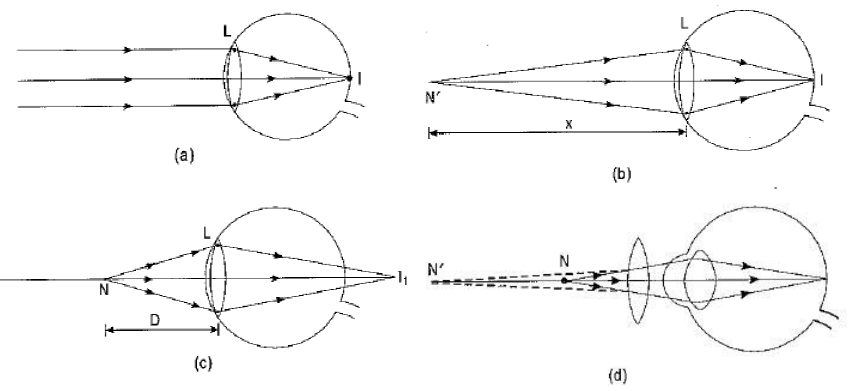
20. What is meant by the dispersion of white light? Draw a neat diagram to show dispersion of white light by a glass prism. What is the cause of dispersion?
Answer: When a beam of white light passes through a glass prism it splits up into its constituent seven colours. The splitting of white light into its constituent colours when light passes through a dispersive medium is called “dispersion of light”. The seven colours, usually expressed as ‘VTBGYOR’ constitute the spectrum of white light.
The ray diagram showing dispersion is given here
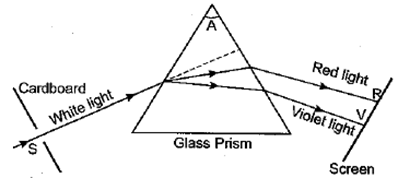
Cause of Dispersion: When a beam of white light enters a glass prism (or any other dispersive medium), the light ray bends towards the normal on entering into glass. However, different colours of light bend through different angles with respect to the incident ray The red light bends the least while the violet light bends the most. So, rays of different colours emerge along different paths and, thus, become distinct. Hence, dispersion is caused and spectrum is formed.
21. State the cause of dispersion of white light by a glass prism. How did Newton, using two identical glass prisms, show that white light is made of seven colours? Draw a ray diagram to show the path of a narrow beam of white light, through a combination of two identical prisms arranged together in inverted position with respect to each other, when it is allowed to fall obliquely on one of the faces of the first prism of the combination.
Answer: Cause of dispersion: From Snell’s law of refraction, the angle of refraction of light in a prism depends on the refractive index of the prism material. Moreover, the refractive index of the material varies inversely with the speed of light and also varies inversely with the wavelength of light. Hence, different colours of white light bend through different angles with respect to the incident light, as they pass through the glass prism.
Newton Experiment: Consider a prism A. When a beam of white light falls obliquely on one of the faces of this prism, it splits up into seven constituent colours. The violet colour deviate the most and the red colour deviates the least. If another identical prism B is placed in an inverted position with respect to first prism A, the constituent coloured rays that emerge out of prism A will be made to merge together to come out as a beam of white light, as shown below.
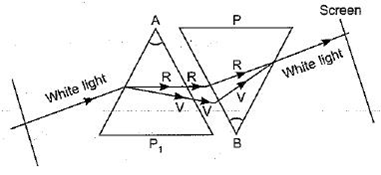
22. Name the type of defect of vision a person is suffering from, if he uses convex lenses in his spectacles for the correction of his vision. If the power of the lenses is +0.5 D, find the focal length of the lenses.
Answer: The defect of vision is hypermetropia.
Focal length of lenses,

23. Describe an activity to show that the colours of white light splitted by a glass prism can be recombined to get white light by another identical glass prism. Also draw ray diagram to show the recombination of the spectrum of white light.
Answer: Recombination of Colours: The colours of white light splitted by a glass prism can be recombined to get white light by another identical glass prism. Newton ; demonstrated this phenomenon of recombination of the coloured rays of a spectrum to get back white light. (а) A triangular prism ABC is placed on its base BC.
(b) A similar prism A ‘B ‘C ‘ is placed alongside with its refracting surface in the opposite direction, i.e., in an inverted position with respect to first prism as shown in figure.

(c) A beam of white light entering the prism ABC undergoes refraction and is dispersed into its constituent seven colours.
(d) These constituent seven coloured rays are incident on the second inverted prism A’B’C’ and get further refracted.
(e) The second prism recombines them into a beam of white light and emerges from the other side of the second prism and falls on the screen.
(f) This is due to the fact that the refraction or bending produced by the second inverted prism is equal and opposite to the refraction or bending produced by the first prism. This causes the seven colours to recombine.
(g) A white patch of light is formed on the screen placed beyond the second prism. This proves the phenomenon of recombination of spectrum of white light.
24. What is the function of retina in the human eye?
Answer: The retina behaves like a light sensitive screen, on which real and inverted image of any object situated in front of eye is formed.
25. What is the function of the crystalline lens of the eye?
Answer: It provides the fine adjustment of focal length of eye lens system so as to focus images of objects situated at different distances on the retina.
26. Write the function of iris in the human eye.
Answer: Iris controls the size of the pupil
27. State the role of ciliary muscles in accommodation of eye.
Answer: To adjust/raodify the shape (curvature) of eye lens so that its focal length can be increased or decreased.
28. What are the values of (i) near point and (ii) far point of vision of a normal adult person? [CBSE 2011,2012,2015,2016]
Answer: (i) 25 cm, (ii) infinity.
29. Name two possible causes of myopia.
Answer: (i) Excessive curvature of the eye lens.
(ii) Elongation o f the eyeball.
30. An old person is unable to see clearly nearby objects as well as distant objects clearly. What defect of vision he is suffering from ?
Answer: The old person is suffering from presbyopia.
31. Priya prefers to sit in the front row as she finds it difficult to read the blackboard from the last desk of her class room. State the defect of vision she is suffering from.
Answer: Priya is suffering from myopia (near sightedness).
32. Name the component of white light that deviates (i) the least and (ii) the most while passing through a glass prism.
Answer: (e) Red light is deviated the least and (ee) Violet light is deviated the most.
33. What will be the colour of the sky when it is observed from a place in the absence of any atmosphere?
Answer: Black (dark).
34. Why is red colour selected for danger signal lights?
Answer: Red light is least scattered by fog or smoke and can be easily seen from a distance.
35. (a) What is the function of iris and pupil of the eye ?
(b) How does the focal length of the eye lens change as per distance of the object in front of the eye?
Answer: (a) The iris controls the size of the pupil. It adjusts in size, and therefore, helps in regulating the amount of fight entering the eye through a variable aperture ‘pupil’. When the fight is very bright, the pupil becomes very small. However, in dim fight, it opens up completely through the relaxation of the iris.
(b) The crystalline eye lens consists of a fibrous, jelly-like material. Its curvature can be modified to some extent by the ciliary muscles. The change in the curvature of eye lens can change its focal length. When the muscles are relaxed, the lens is thin and its focal length is more (about 2.5 cm). When the ciliary muscles contract and the eye lens becomes thicker. Consequently, the focal length of eye lens decreases.
36. What is a prism? Draw a neat diagram to show refraction of a light ray through a triangular glass prism. Define angle of deviation. [CBSE 2011,2013,2014,2016]
Answer: An optical prism has two triangular bases and three rectangular lateral surfaces, which are inclined to each other. Angle between its two lateral faces is called the angle of prism.
The labelled diagram has been shown in Fig in which ∠PEN = ∠i = angle of incidence, ∠N’EF = ∠r = angle of refraction and ∠MFR = ∠e = angle of emergence.

Whenever refraction of light takes place through a prism, the emergent ray bends towards the base of the prism. The angle between the directions of incident ray and emergent ray is called the angle of deviation D.
37. Explain why the planets do not twinkle but the stars twinkle.
Answer: Stars are very far away from the earth and behave as almost a point object. The atmosphere is made of several layers and their refractive indices keep on changing continuously. So the light rays coming from the star keep on changing their paths continuously. As a consequence, the number of rays (or the light energy) entering in the pupil of the eye goes on changing with time and the stars appear twinkling.
A planet is comparatively nearer to the earth and subtends a larger angle at the eye. So, it may be considered as a collection of large number of point sized objects. Due to atmospheric refraction, quantity of light coming from any one point sized object changes with time but the total light entering the observer’s eye due to all these point objects remains almost the same. As a result the planet does not twinkle.
38. Explain with the help of a diagram, how we are able to observe the sunrise about two minutes before the sun gets above the horizon. Hence, explain why does apparent duration of a day from sunrise to sunset is 4 minutes more than its actual duration.
Answer: The air becomes rarer as its height above the earth increases. Its refractive index decreases. A ray of light from the Sun when it enters the atmosphere at the horizon gets refracted from a rarer to a denser medium. The rays, therefore gradually bend towards the normal and the Sun appears to be raised. As a result, the Sun is visible to an observer nearly two minutes before actual sunrise at the horizon. Similarly, even after actual sunset, Sun is seen by us for about 2 minutes. Thus, in effect Sun is seen for 4 minutes more. It means that apparent duration of day (from sunrise to sunset) has increased by 4 minutes than its actual duration.

39. What is a pupil?
Answer: The pupil is a small circular transparent aperture whose size is controlled by iris.
40. Name the condition resulting due to the eye lens becoming cloudy.
Answer: Cataract
41. What is dispersion of light?
Answer: Dispersion of light is the splitting of light into its component colours on passing through a dispersive medium e.g., a prism.
42. List the factors on which scattering of light depends.
Answer: Scattering of light depends on the size of scattering particle and the wavelength of light.
43. (a) Write the function of each of the following parts of human eye :
(i) Cornea
(ii) Iris
(iii) Crystalline lens
(iv) Ciliary muscles.
(b) Why does the sun appear reddish early in the morning ? Will this phenomenon be observed by an astronaut on the Moon ? Give reason to justify your answer.
Answer: (a) The function of given parts is stated below :
(i) Cornea is the outer bulged out in transparent layer of eye and provides most of the refraction for the light entering into the eye.
(ii) The iris controls the size of the pupil of eye.
(iii) The crystalline lens provides the finer adjustment of focal length required so as to focus objects situated at different distances in front of the eye on the retina.(iv) The ciliary muscles help in controlling the curvature of crystalline lens and thus can change the power of the crystalline lens.
(b) In the early morning, the Sun is situated near the horizon. Light from the Sun passes through thicker layers of air and covers a larger distance in the earth’s atmosphere before reaching our eyes. While passing through atmosphere blue light is mostly scattered away and the Sun appear reddish as shown in Fig.

The phenomenon is not observed by an observer on the Moon because the Moon has no atmosphere of its own and hence no scattering of light is possible.
44. (a) What is meant by the term power of accommodation? Name the component of eye that is responsible for the power of accommodation.
(b) A student sitting at the back bench in a class has difficulty in reading. What could be his defect of vision? Draw ray diagram to illustrate the image formation of the blackboard when he is seated at the (i) back seat (ii) front seat. State two possible causes of this defect. Explain the method of correcting this defect with the help of a ray diagram.
Answer: (a) Power of accommodation: The ability of eye lens to adjust its focal length to form a sharp image of the object at varying distances on the retina is called power of accommodation. Ciliary muscles of eye are responsible for change it the focal length of eye lens.
(b)
- Student is suffering from myopia or short sightedness or nearsightedness.
- When student is seated at the back seat.

In this case student is suffering from myopia and have short focal length of eye lens.
(ii) When student is seated at front seat.

Causes:
(i) Excessive curvature of eye lens
(ii) Elongation of eye ball.
The defect is corrected by using a concave lens of suitable power placed in front of eye as shown below. It diverge the rays and forms a virtual image of distant object at far point of the myopic eye. These diverged rays enter into the eye and form the image on the retina. Thus, the concave lens shifts the image back onto the retina instead o f in front of it and the defect is corrected.
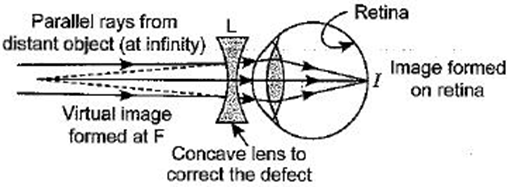
45. (a) What is presbyopia? State its cause. How is it corrected?
(b) Why does the sun appear reddish early in the morning? Explain with the help of a labelled diagram.
Answer: (a) (i) Presbyopia
- Presbyopia is a condition that occurs as a part of normal ageing.
Due to loss of power of accommodation of the eye, with age, objects at a normal near working distance will appear blurry. The near point gradually recedes away. This defect of eye is called Presbyopia. - Sometimes, a person may suffer from both myopia and hypermetropia.
(ii) Presbyopia is caused due to
- weakening of ciliary muscles, and
- eye lens becomes less flexible and elastic, i.e. reducing ability of eye lens to change its curvature with the help of ciliary muscles.
(iii) Bifocal lens will be required to see clearly nearby as well as the distant object. For myopic defect, upper part of bifocal lens consists of a concave lens used for distant vision and to correct hypermetropia, lower part of bifocal lens consists of a convex lens. It facilitates near vision.
(b) At the time of sunrise/sunset, the sun is near the horizon, so the sunrays have to travel through a larger atmospheric distance. The fine particles of the atmosphere scatter away the blue component and other shorter wavelengths of the sunlight. As λb < λr, only red colour having longer wavelength and least scattered, reaches our eyes. Hence, the sun appears red at sunrise or sunset.

46. (a) What is dispersion of white light? State its cause.
(b) “Rainbow is an example of dispersion of sunlight” Justify this statement by explaining, with the help of a labelled diagram, the formation of a rainbow in the sky. List two essential conditions for observing a rainbow. [Foreign 2016]
Answer: (a) Dispersion: The splitting up of white light into its component colours is called dispersion.
Cause of dispersion: From Snell’s law of refraction, the angle of refraction of light in a prism depends on the refractive index of the prism material. Moreover, the refractive index of the material varies with the speed of light. The different constituent colours of white light have different speeds in the transparent material of prism. Hence for each colours/wavelength, the refractive index of prism material is different. Therefore, each colour bends (refracted) through different angle with respect to incident ray, as they pass through the prism. The red colour has maximum speed in glass prism, so it is least deviated, while the violet colour has minimum speed so its deviation is maximum. Thus, the ray of each colour emerges along different paths and becomes distinct.
(b) Rainbow: It is an optical natural spectrum, produced by the nature in the sky, in the form of a multicoloured arc. The rainbow is formed due to the dispersion of sunlight by water droplets suspended in the atmosphere after rainfall. These water droplets act like small prisms. The Sunlight enters the water droplets. At the point of incidence, it refracts and disperses then gets reflected internally and finally gets refracted again at the point of emergence as it comes out of the rain-drop.
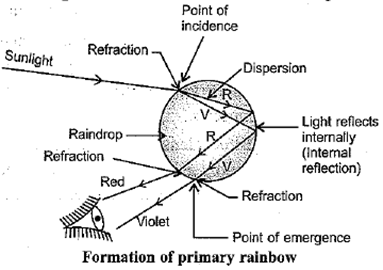
Therefore, due to refraction, dispersion and internal reflection of the sunlight, different colours reach the observer’s eye along different paths and become distinct. It creates a rainbow in the sky.
Hence “Rainbow is an example of dispersion of sunlight.”
Necessary conditions for the formation of a rainbow.
(i) The presence of water droplets in the atmosphere, and
(ii) The sun must be at the back of the observer, i.e. the observer must stand with his back towards the sun.
47. What is atmospheric refraction? Use this phenomenon to explain the following natural events.
(a) Twinkling of stars
(b) Advanced sunrise and delayed sunset.
Draw diagrams to illustrate your answers.
Answer: Atmospheric Refraction: The refraction of light caused by the earth’s atmosphere due to gradual change in the refractive indices of its different layers by the varying conditions of it, is called atmospheric refraction.
(a) Twinkling of stars
The hot layers (low densities) of air at a high altitude, behave as an optically rarer medium for the light rays, whereas the cold dense layers (high densities) of air near the earth’s surface, behave as an optically denser medium for the light rays. So, when the light rays (starlight) pass through the various layers of atmosphere, they will get deviated and bent toward the normal. As a result, the apparent position of star is slightly different from its actual position. Thus, the stars appear slightly higher (above) than their actual positions in the sky.
The fluctuation in the positions of the stars occurs continuously due to the changing amount of light entering the eye. The stars sometimes appear brighter and at some other times, they appear fainter. This causes twinkling of stars.
(b) Advanced sunrise and delayed sunset The sun is visible 2 minutes before sunrise and 2 minutes after sunset because of atmospheric refraction. This can be explained as below.
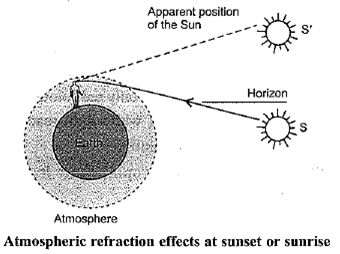
The figure shows the actual position of the sun S at the time of sunrise or sunset, just below the horizon while the apparent position S) above the horizon as appear to us.
When the sun is slightly below the horizon, the light rays move through the different layers of varying refractive indices of air and get bent towards the normal. These rays appear to come from S) which is the apparent position of the sun. That is why, the sun is visible to us when it has – been actually below the horizon or before the actual crossing of horizon by the sun at the time of sunrise or sunset. So, due to the atmospheric refraction, the phenomenon of advanced advance sunrise and delayed sunset is observed.